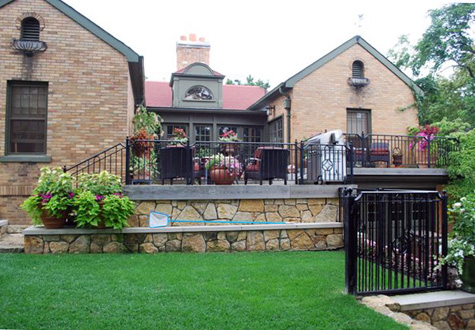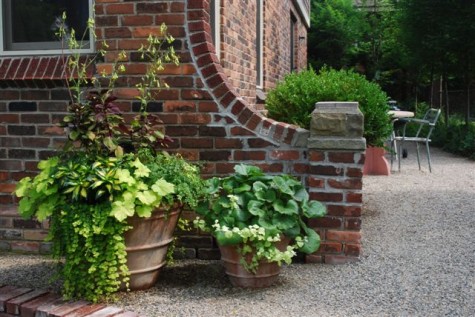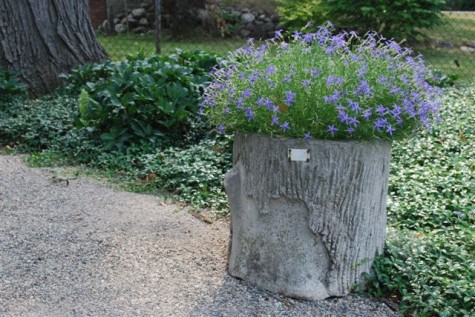
The benign looking mini- roof structure you see in the above picture houses my folly. Folly? The Oxford English Dictionary defines them as “…any costly structure considered to have shown folly in the builder.” Others have described them as buildings, or remnants of buildings useful only as ornament. I am greatly enamoured of the shell grottoes in England and Italy. Not to mention sculpture at Bomarzo in Italy, or the French folly garden Le Desert de Retz by Monsieur de Monville. Somehow I got the idea that I should have one, though no shell structure could survive an outdoor installation in my zone. Nor would my 1930’s vintage house suffer some 19th century ruin wedged into the side half-lot. So bring the garden inside. The fact that I designed and built this mini-tower through the roof of my back porch, encrusted it in glass and shells-a project that took more money and even more time than I ever imagined-makes this a folly, no question.

I had a contractor cut a 6′ by 6′ hole in my porch ceiling, and build a four sided exterior plywood tower with half moon windows that goes up 14 feet from the floor of my porch to a squarish dome. He shingled the structure with left over shingles I found in a closet in the basement. He covered the outside in MDO board, milled and installed moldings, and finished the outside gracefully; only I see the folly part-not my neighbors. No, I did not apply for a permit for this; can you imagine the questions? He also removed the plaster ceiling of the porch, and installed more plywood; I had something weighty in mind. He thankfully never inquired abut my intentions-how would I have explained?

I rented a scaffolding (which I was sure I wouldn’t need longer than 3 weeks) and assembled two ladders. One ladder to get me to the platform, and another to get me up to the top. I glued some 900 pounds of recycled, tumbled bottle glass fragments on the ceiling one piece at a time. Each frosted white, random sized piece, I buttered liberally with ceramic tile mastic, and pushed into the surface, until it stuck. I am sure you are starting to understand that I had no idea what would really be involved in making this.

It was a huge relief to get off the glass part, to the shelling; I could stand on the scaffolding and work. Working high up on that ladder, over my head made me very uneasy. I had no plan for the shells. I bought numbers of shells that I liked from Shell Horizons in Florida-by the gallon, or by the pound. White, orange, and orange-brown. Then I tinkered, until it seemed like I had a design that would work.

Obviously this was a winter project. I would go to work for 2 hours in the morning, and two hours in the afternoon, and glue shells in between. For what seemed like a lifetime. It seemed like every week I needed more shells. Not the least of my concerns was that I had planned to shell the entire porch ceiling, once the tower was done. I started to worry I would never have the stamina to finish.
 Happily I came to my senses when the tower was done. More shells on the ceiling would just distract from the tower, right? So I mossed the ceiling; a little construction pressure can jump start the imagination. Gluing dried moss onto sheets of foam core that could be stapled to the plywood in big sheets-the construction of this part of the folly took long-but not nearly as long as that tower.
Happily I came to my senses when the tower was done. More shells on the ceiling would just distract from the tower, right? So I mossed the ceiling; a little construction pressure can jump start the imagination. Gluing dried moss onto sheets of foam core that could be stapled to the plywood in big sheets-the construction of this part of the folly took long-but not nearly as long as that tower.

No doubt this has that folly aura, but I absolutely love it. Having admired shelled grottoes, buildings, furniture and the like my entire gardening life, I no longer needed to dream about having one of my own.




















